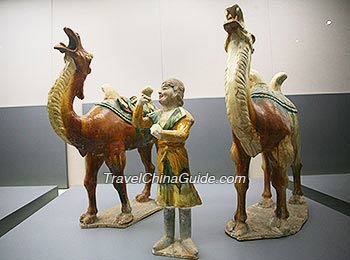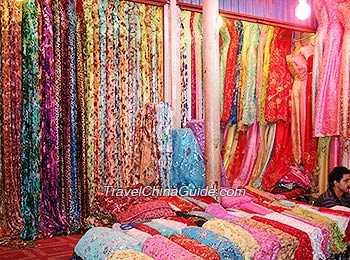 |
Tri-color Painted Pottery of
a Persian Businessman and Camels |
During the last period of the
Western Han Dynasty (206 BC–24 AD), Wang Mang usurped the throne, established the Xin Dynasty (9–23). The society was in turbulence and peasant revolts broke out one after another. In 23, the Protectorate of Western Regions was cancelled. The Northern Huns seized the opportunity to reign over the Western Regions.
In 25, the Eastern Han Emperor Liu Xiu (Guangwu Di) re-established the Han Dynasty with the capital of Luoyang. The minority people in Western Regions couldn't bear the heavy tax under the Northern Huns' cruel rule, so eighteen states in the Western Regions asked Guang Wudi to set up the protectorate in 45. However, in order to stabilize society and develop economy, the emperor refused their request. In 74, the protectorate was re-established by emperor Mingdi (Liu Xiu's son) to oversee the Western Regions. In the next year, as soon as Mingdi died, Yanqi and Qiuci (Kuche) rebelled. This remote region fell into disorder again.
Ban Chao pacified the Western Region
It was not until 91 that the Protectorate of Western Regions was re-established with the protector
Ban Chao in Qiancheng (near now Kuche). The famous general and diplomat, Ban Chao lived in the Western Regions for about 31 years, put down countless rebellions and built diplomatic relations with more than 50 states, ensuring the peace and stability along the Silk Road.
Gan Ying went to the Roman
 |
| Silk Products Sold in Kashgar Bazaar |
In 97, Gan Ying was dispatched by Ban Chao to Daqin (the Roman Empire) for trading with Romans directly. He set out on his journey from Qiuci (Kuche), traversed inhospitable deserts, went over snow-covered Pamirs, by way of Tiaozhi (now Iraq) and the Anxi Empire (Parthia) and finally reached the Persian Gulf. Being afraid of the difficulty of crossing the boundless sea, he gave up halfway. Although Gan Ying failed to finish his mission, he brought more detailed and reliable information about Central Asia.
Ban Yong stabilized the Western Regions
Soon after Ban Chao left the Western Regions, the dependent states of the Protectorate rebelled in succession. In 123,
Ban Yong was appointed the Protector and stationed 500 soldiers in Liuzhong (in the west of Ruoqing). In the next year, he persuaded Shanshan (Ruoqiang) and Qiuci (Kuche) to return to the Han's dominion, vanquished Cheshi Qianbu (in Turpan) and defeated a king of the Hun, re-opening up the Central Route of the Silk Road. In 126, he sent forces to suppress the Huyan King, capturing more than 20, 000 Huns. Ban Yong consolidated the reign of Eastern Han Dynasty in this faraway area and greatly protected this ancient Silk Road.
During the Han Dynasty, the trade of the Silk Road in Western Regions was frequently disrupted by the internal disorder and invasion of the nomad Huns. In a word, the Silk Road emerged through difficulties and rose to be a famous international trade route between China and the Mediterranean.
- Last updated on May. 31, 2023 by Catherine He -

